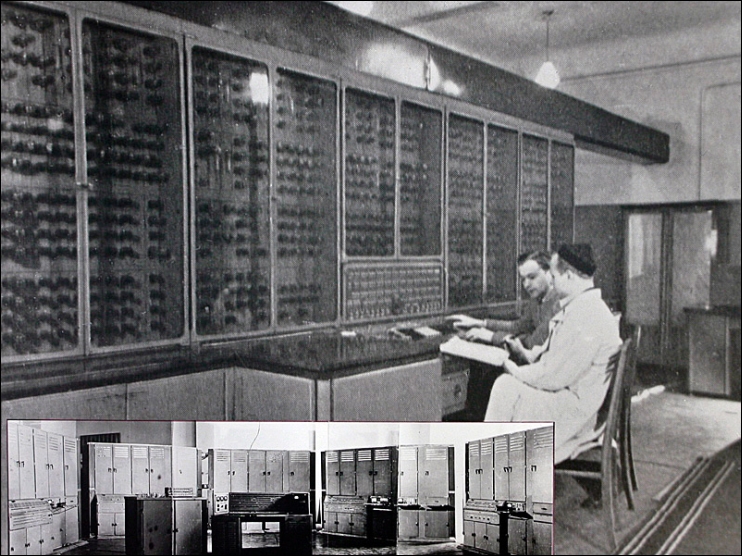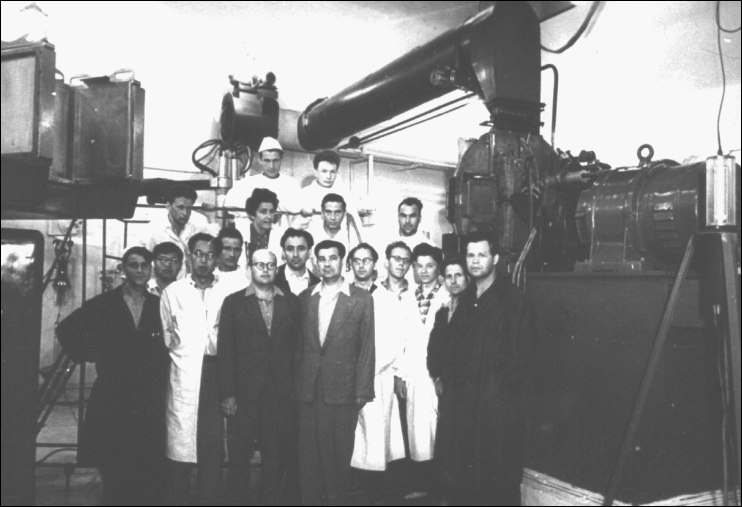Peaceful Atom
In the Russian Federation the history of nuclear industry development goes hand in hand with the advances made in the field of theoretical and experimental nuclear and particle physics, which, in turn, would be impossible without construction of powerful facilities of unique complexity and precision – particle accelerators and nuclear reactors.
Research in nuclear physics started in the days of the Great Patriotic War at the initiative of Academician I.V. Kurchatov, who took the leadership in the development of Soviet atomic science and technology and gathered his students and a number of prominent Soviet scientists in Moscow.
 Professor I.V.Kurchatov together with a postgraduate student M.G. Meshcheryakov working at the first Soviet cyclotron in the Radium Institute, 1936
Professor I.V.Kurchatov together with a postgraduate student M.G. Meshcheryakov working at the first Soviet cyclotron in the Radium Institute, 1936
From the memories of M.G.Meshcheryakov, in the second half of 1944 in the circles of Soviet scientists involved in nuclear physics research a discussion began considering the possibility of construction of particle accelerators in our country. Several meetings on this subject were held under the supervision of Academician I.V.Kurchatov in Laboratory No.2 of the USSR Academy of Sciences. Later on, this Laboratory founded by the prominent scientist was transformed into the Institute of Atomic Energy of the USSR Academy of Sciences (nowadays, the Research Centre “Kurchatov Institute”). The discussions resulted in an idea that in order to support the promising areas of fundamental physical research in the Soviet Union it was necessary to build two accelerators at record-setting energies – a proton accelerator at 450-500 MeV with a subsequent increase of up to 650-700 MeV and an electron accelerator at an energy of at least 250 MeV.
According to the decision of the Government of the USSR, in order to build an accelerator and its scientific campus a strip of forested wetland on the right bank of the upper Volga River near the village of Bolshaya Volga was allocated from the State Fund (1946). On the grounds of secrecy and proximity to the Moscow Sea, the accelerator laboratory founded there in 1948 was named the Hydroengineering Laboratory of the USSR AS.
 Mikhail Grigorievich Meshcheryakov and Venedikt Petrovich Dzhelepov
Mikhail Grigorievich Meshcheryakov and Venedikt Petrovich Dzhelepov
M.G.Meshcheryakov was appointed Director of the Hydraulic Engineering Laboratory and Scientific Director for Accelerator Development, while V.P.Dzhelepov became Deputy Director. Designing of the accelerator magnet and electrical equipment was carried out at the Leningrad plant “Electrosila” under the supervision of D.V.Efremov, a specialist of the design bureau. The development of high-frequency accelerator system and powerful high-frequency generator was carried out under the supervision of A.L.Mints, Corresponding Member of the USSR AS.
Within a short period of time, under adverse conditions, the main building of the Synchrocyclotron was erected. The height of its massive walls reached 35 m, the thickness of the concrete ceiling was 2 m and its total weight exceeded 10 000 tons.
At the same time with the construction of the accelerator, the main laboratories and the residential area of the scientific campus – future Dubna – were being built. A.P.Lepilov, one of the most experienced builders of large objects, was in charge of this work. An important part in solving the problems of urban development was played by M.G.Meshcheryakov. He was the one who started forging the social image of future Dubna – a city with a remarkable atmosphere of invisible work of human thought.
The Synchrocyclotron was ready for operation within a record-breaking period – it was launched on December 14, 1949. This historical episode enabled the development of a new field of scientific research – high energy particle physics. At the Synchrocyclotron deuterons were accelerated up to the energy of 280 MeV, α-particles – up to 250 MeV, and afterwards, protons – up to 480 MeV. Until 1953 the Synchrocyclotron had been the largest accelerator in the world.
 The building of the Synchrocyclotron, the first accelerator in Dubna
The building of the Synchrocyclotron, the first accelerator in Dubna
In 1953, after increasing the diameter of the Synchrocyclotron magnet poles up to six meters and a substantial renovation of its high-frequency system, a 680-MeV proton version of the accelerator was put into operation.
Rapid development of experimental research at the Synchrocyclotron and acquisition of the top-line scientific results enabled transformation of the Hydroengineering Laboratory into the Institute of Nuclear Problems of the USSR AS in 1953.
In 1944, V.I.Veksler discovered the principle of phase stability underlying the operation of cyclic accelerators at high and superhigh energies.
In 1949, under the leadership of V.I.Veksler and with the active support of Academician S.I.Vavilov, in the vicinity of future Dubna designing of another powerful proton accelerator – Synchrophasotron at 10 GeV – was started.
 Vladimir Iosifovich Veksler
Vladimir Iosifovich Veksler
In the process of the accelerator construction many problems in the field of electrical equipment engineering and special materials had to be solved. To develop the projects on building unique equipment for the Synchrophasotron V.I.Veksler attracted scientific and engineering teams headed by D.V.Efremov and A.L.Mints.
 The main building of the Synchrophasotron
The main building of the Synchrophasotron
They designed and built a giant electromagnetic ring (36 000 tons) made of special-grade steel, a special layout of power supply, radiotechnical equipment, and unique measuring instruments.
In the process of development of radiotechnical and electronic devices, a new branch of engineering science emerged – radio engineering and electronics of powerful charged-particle accelerators.
In 1953, a security-guarded site, where the Synchrophasotron had been under construction, obtained its official name – the Electrophysical Laboratory of the USSR AS (EPLAS).



















